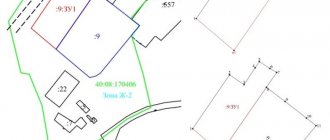Home / Real estate / Land / Provision
Back
Published: 01/09/2017
Reading time: 15 min
0
1665
In Russia, certain categories of citizens have the opportunity to obtain land for construction from the state.
This can be done on a paid or free basis. Land is provided for rent or temporary use.
- Legislation
- Reasons for receiving
- Conditions of receipt
- Required documents
- Regulations on the provision of land plots for the construction of residential buildings
- When is refusal possible?
- Important details to pay attention to
Legislation
A plot is a part of the earth's surface, the boundaries of which have been certified in the prescribed manner. The procedure for providing land owned by state and municipal authorities is prescribed in the Land Code. Certain provisions are contained in the Civil Code.
Russians are guaranteed equal access to land. State and municipal authorities have the right to lease land (ownership) on a paid basis or free of charge.
A type of lease agreement is a transaction with the purchase of a plot from the state at a symbolic price.
The right to determine criteria for land allocation free of charge is assigned to the regions. At the same time, at the time of its transfer, the site must have clear boundaries, be registered in the cadastral register and be displayed on the Rosreestr map.
The minimum and maximum size of plots is set at the discretion of local authorities. They depend on the region where land plots are provided for housing construction, the availability of free land, the economic situation in the region, etc. Typically, the minimum allotment is 3 acres, the maximum is 1.5 thousand sq.m.
Land legislation provides for two procedures for providing plots for individual housing construction: without bidding and with an auction. Here are a number of reasons for providing land without bidding:
- sale of land (clause 2 of article 39.3 of the Land Code);
- provision of land free of charge (Article 39.5);
- when concluding a lease agreement without bidding (Article 39.6);
- provision of plots for free use.
Thus, land for individual housing construction can be obtained free of charge without bidding. At the same time, the Land Code states that executive authorities are required to publish a notice of preliminary approval for the allocation of land to a citizen.
If no other applications for participation in the auction are received, then the authorities are obliged to allocate the site without bidding.
Repeated publication of the message by the executive body is not required.
Reasons for receiving
The Land Code secures the right to land plots for large families on a free basis.
These include families that are officially married and have three or more minor children. Heroes of the USSR and the Russian Federation can also receive land for individual housing construction.
Tenants who received the right to use it back in Soviet times and built a house on it can count on the transfer of a land plot into free ownership. Or the owners of land that was allocated to them on the basis of perpetual or lifelong ownership.
The right to free plots is assigned to them at the federal level.
The remaining categories of beneficiaries are determined at the regional and municipal level.
It is local authorities who have the right to determine groups of citizens who are allocated free land. Typically these include:
- persons who are officially recognized as in need of improved housing conditions (living space per person in a family is less than the regional standard in sq.m., live in a dilapidated house or dormitory);
- persons with disabilities and members of their families;
- families who care for disabled children;
- veterans of the Second World War and military operations or families who lost their breadwinner during military operations;
- young specialists working in priority professions under programs to attract in-demand personnel to the village;
- pensioners who permanently reside in the village;
- disabled people or members of their families.
All of these persons can exercise their right to a free plot of land only once .
Among the citizens who could apply for land plots to build a house there, one can distinguish a group of persons with priority rights. These are large families and families with disabled children.
Conditions of receipt
The conditions for obtaining land for individual housing construction are different in each region. For example, to provide free land for individual housing construction in Crimea, you must live on the peninsula for at least 5 years. Whereas any citizen of the Russian Federation can receive a hectare of land in the Far East, regardless of registration . The main thing is that he is engaged in the exploration and development of the territory entrusted to him.
The conditions for the applicant may include the following:
- having the status of a young family (in which both spouses are no more than 35 years old) or a large family (in which there are three or more minor children);
- resolution recognizing a family in need of improved housing conditions;
- having the status of a young specialist, working in one of the priority areas in a medical or educational profile when concluding an open-ended employment contract within a rural settlement, etc.;
- availability of an official conclusion recognizing the child as disabled.
It is usually required that the citizen does not own any other land for similar needs.
So, if he or members of his family own a plot of land for a summer cottage, this does not deprive them of the right to be allocated free land for building a house. But they will not be provided with land for individual housing construction again.
Required documents
The list of documents that will be required to obtain land from the administration depends on the category of benefits. Typically, the list of requested documentation includes:
- passports of all family members/birth certificates;
- a document confirming registration in the region for 3–5 years (this can be a stamp from a passport or a court decision);
- a certificate from local government authorities stating that the citizen has not previously used his right to a free plot;
- a document confirming the right to benefits (medical certificate of disability, work record book, certificate of a combat veteran, pension certificate, etc.).
Regardless of the category of citizen, he must provide a completed application for the allocation of land. The application is submitted for the purpose of preliminary approval of the selected site or for the allocation of land without bidding.
After receiving such approval, another application is submitted with a request to provide the site. It indicates the purpose of the object, the proposed location of construction of the building and its area, justification for the size of the land, the requested right to the land (lease, ownership).
In the future, after the construction of the house, together with the lease agreement (or other agreement), passports, cadastral documentation, you can re-register the plot as property.
Free Far Eastern hectare.
From February 2021, any Russian can get 1 hectare in the Far East.
After 5 years of intended use of the land, the Far Eastern hectare can be registered as a property for free.
A tempting offer is to get a plot of land in the taiga, where there are no roads or electricity.
And where mosquitoes knock you off your feet.
The Deputy Governor of the Khabarovsk Territory stated in one television program that the governor himself (V.I. Shport) was looking for a plot of land.
It's very interesting to see what will happen in the end.
For reference.
Shport V.I. lost the elections in September 2021 and quickly moved to Moscow.
It seems that the ex-governor of Khabarovsk is not eager to develop the Far Eastern hectare.
Who is interested in obtaining land in the Far Eastern taiga, start with paragraph 9 of Article 39.5 of the Land Code of the Russian Federation.
Regulations on the provision of land plots for the construction of residential buildings
The general regulations for the provision of land for individual housing construction are prescribed in the Land Code. Article 30 provides two options for the allocation of land from state and municipal property:
- without prior approval of the location of objects;
- provision of land plots for construction with prior approval.
According to land and town planning legislation, preliminary approval is not required in some cases. In particular, if the object is located within a city or village and complies with urban planning documentation and zoning of the territory. Also, preliminary approval is not required when allocating land for agricultural or forestry needs or to a citizen for individual construction or running private household plots.
The sequence of obtaining a land plot can be represented as follows:
- The applicant prepares a layout diagram of the land plot and submits an application for its preliminary approval to the authorized body. If the application does not comply with the established form or all necessary documents have not been attached to it, then the applicant is given a refusal in writing.
- Within no more than 30 days, the authorized body is obliged to publish a notice of the provision of the site. It is published only once.
- If other applications for this site are received within a month, then within 7 days a decision is made to refuse preliminary approval and an auction is announced. After the auction, a protocol with its results or a decision to declare it invalid is signed.
- If it was not possible to find others willing, then a positive decision is made to approve the land.
- The interested party carries out cadastral work to form a plot or clarify its boundaries with the help of a cadastral engineer. Two years are allowed for this after receiving preliminary approval. When carrying out these works, the boundaries of the site are established on the ground and their plan is prepared; if necessary, boundary signs are installed on the ground. The next stage: determining the permitted use of the land and technical conditions for connecting to utility networks.
- The plot is registered with the state cadastral register, and technical documentation is obtained for it.
- A new application is submitted to the authorized body with a request to provide a plot of land. The decision to refuse or provide land is made within 30 days.
- If the decision is positive, municipal authorities prepare draft lease agreements, free use or purchase and sale agreements. If the lease agreement is concluded for a period of more than a year, then it must be registered with Rosreestr. If it is indefinite, then registration is not necessary. After building a house on the land, ownership of the building must be registered with Rosreestr.
On March 1, 2015, a new procedure for the formation and provision of land from state and municipal property to individuals and legal entities came into force in Russia. The key points of the new order are reflected in the Federal Law of June 23, 2014 No. 171-FZ “On Amendments to the Land Code of the Russian Federation and Certain Legislative Acts of the Russian Federation” (hereinafter referred to as Law No. 171-FZ). These innovations are part of the large-scale land reform currently underway. In general, they are designed to make the process of acquiring land, both for rent and ownership, more understandable and transparent.
Law No. 171-FZ was developed and adopted with the aim of improving the procedure for providing land plots and urban planning regulation. Until this moment, the procedure for providing land plots was not properly regulated in legislation. For example, previously, only a land plot that had all the necessary characteristics could be at the disposal of an individual or legal entity: borders, cadastral number. In addition, this was possible only if the land plot had a right holder. Also, in practice, the transfer of unformed land plots, especially from state ownership, often caused great difficulties. Now these and many other points in the procedure for granting land have undergone changes. In addition, it should be noted that the legislator introduced the concept of “land plot” into the Land Code of the Russian Federation. According to paragraph 3 of Art. 6 of the Land Code of the Russian Federation, a land plot as an object of ownership and other rights to land provided for by law is an immovable thing that represents a part of the earth’s surface and has characteristics that make it possible to define it as an individually defined thing. The conditions for the provision of land plots have changed. Innovations establish a new basic principle, in which the use of the territory is first planned, and then the land plot is provided in accordance with its defined function, and not vice versa, as was the case before the changes were made. Now the formation of land plots from lands or plots in state or municipal ownership is carried out in accordance with one of the following documents: a territory surveying project approved in accordance with the Town Planning Code of the Russian Federation, project documentation on the location, boundaries, area and other quantitative and qualitative characteristics of forest plots, an approved layout of a land plot or land plots on the cadastral plan of the territory. Thus, the old procedure for preliminary approval of the location of an object has been abolished. At the same time, the new procedure for determining the boundaries of a land plot is now in no way connected with the grounds for its provision. It is important that in the absence of an approved land surveying project, the formation of land plots from lands or plots in state or municipal ownership is permitted in accordance with the approved layout of the land plot or land plots on the cadastral plan of the territory. However, the law provides for cases when it is possible to form a land plot only if there is a land surveying project: from a land plot provided for the integrated development of the territory (that is, integrated development), from a land plot provided to a non-profit organization created by citizens for gardening, gardening, summer cottages economy or for the conduct of dacha farming by other legal entities, within the boundaries of the territory in respect of which, in accordance with the legislation on urban planning activities, an agreement on its development has been concluded (for example, if it is necessary to demolish a block of dilapidated housing and build a new one in its place), within the boundaries of an element of the planning structures built up with apartment buildings (that is, again within the boundaries of the block), for the placement of linear objects of federal, regional or local significance (pipelines, power lines, etc.). Thus, large-scale issues of land development require a land surveying project, but in other cases, you can get by with a land plot layout diagram. In addition to executive bodies of state power or local government bodies, citizens and legal entities can participate in the preparation of a land plot plan. The validity period of the decision to approve the scheme is two years. Moreover, if the boundaries of the land plot, which is formed in accordance with the site layout diagram, intersect with the boundaries of the site or plots formed in accordance with the territory surveying project, approved after the date of approval of the site layout diagram and before the expiration of the decision on its approval, formation land plot is carried out in accordance with the approved layout plan. The procedure for obtaining a plot through the procedure of preliminary approval of the location of the object has been abolished. Since March 1, 2015, a closed list of documents has been established - the grounds for transferring the right to a land plot owned by the state or municipality. In accordance with paragraph 1 of Art. 39.1 of the Land Code of the Russian Federation, the grounds for the emergence of rights to land plots provided from lands in state or municipal ownership are: § a decision of a state authority or local government body in the case of the provision of a land plot into ownership free of charge or for permanent (perpetual) use; § purchase and sale agreement in case of provision of ownership of a land plot for a fee; § lease agreement in case of provision of a land plot for rent; § agreement for free use in case of provision of a land plot for free use. At the same time, as a general rule, the sale of state or municipally owned land plots, the main type of permitted use of which is the construction of buildings and structures, is not permitted. Exceptions to this rule are provided in paragraph 2 of Art. 39.1 and paragraph 2 of Art. 39.3 of the Land Code of the Russian Federation (in particular, exceptions include land plots formed as a result of the division of a site, provided by a non-profit organization created by citizens for the comprehensive development of the territory for the purpose of individual housing construction and related to public property of this non-profit organization). It should also be noted that the new rules do not provide for obtaining land without bidding through the procedure of preliminary approval of the location of the facility, and the main forms of providing public land for construction are rent and auction. Now, during an auction, it is prohibited to combine two or more land plots that are state or municipal property into one auction lot, unless otherwise provided by federal law. Also in accordance with paragraph 14 of Art. 39.8 of the Land Code of the Russian Federation, a lease agreement for a land plot located in state or municipal ownership cannot establish requirements for the performance of any work or provision of services that entail additional costs for the tenant not related to the subject of this agreement, unless otherwise provided by federal law . This means a direct ban on the inclusion in the text of the agreement of any “social” or “investment” conditions that took place in previous practice. Methods for transferring rights to a state or municipal land plot The Land Code, as amended by Law No. 171-FZ, establishes various ways to transfer rights to a state or municipal land plot: 1) into ownership for a fee (Article 39.3 of the Land Code of the Russian Federation). The sale of land plots in state or municipal ownership is carried out only at auction. Without holding a tender, land plots are sold in a special manner for the integrated development of the territory, for individual housing construction, for gardening, gardening, dacha farming, for owners of buildings, structures or premises in them; 2) free of charge (Article 39.5 of the Land Code of the Russian Federation). The provision of state or municipal land to a citizen or organization free of charge is carried out on the basis of a decision of the authorized body. Including in the following cases: to a person with whom a territory development agreement has been concluded; a religious organization that owns buildings or structures for religious or charitable purposes; municipal employees in accordance with subparagraph. 7 paragraph 2 art. 39.10 of the Land Code of the Russian Federation, large families in cases provided for by law; 3) for rent (paid temporary use). According to Art. 39.6. Land plots of the Russian Federation in state or municipal ownership are leased at auction and without auction. Without holding a tender, land plots can be provided to: § legal entities in accordance with the decree or order of the President of the Russian Federation; § legal entities in accordance with the order of the Government of the Russian Federation for the placement of social and cultural facilities, the implementation of large-scale investment projects; § legal entities in accordance with the order of the highest official of a constituent entity of the Russian Federation for the placement of socio-cultural and public utility facilities, the implementation of large-scale investment projects; § legal entities for the placement of facilities intended to provide electricity, heat, gas and water supply, sewerage, communications, oil pipelines, facilities of federal, regional or local significance; § formed from a land plot in state or municipal ownership, including one provided for the comprehensive development of the territory, to the person with whom the land lease agreement was concluded; § formed from a land plot provided to a non-profit organization created by citizens for the integrated development of the territory for the purpose of individual housing construction, with the exception of land plots classified as public property, to members of this non-profit organization or, if provided for by a decision of the general meeting of members of this non-profit organization , the non-profit organization itself; § to complete construction for owners of unfinished construction projects; § for running a peasant (farm) economy; § for the development of the territory for the purpose of constructing economy-class housing or for the integrated development of the territory for the purpose of constructing economic-class housing; § owners of buildings, structures, premises in them and (or) persons to whom these real estate objects are provided with the right of economic management or, in some cases, with the right of operational management; § formed within the boundaries of the built-up territory - to the person with whom the agreement on the development of the built-up territory was concluded; § citizens for individual housing construction, running personal subsidiary plots within the boundaries of a populated area, gardening, dacha farming, citizens and peasant (farm) farms for the peasant (farm) farm to carry out its activities; § when withdrawing land plots leased by a citizen or organization for state or municipal needs; § in others listed in Art. 39.6 of the Land Code of the Russian Federation in cases; 4) for free (temporary) use (Article 39.10 of the Land Code of the Russian Federation). Land plots may be provided for free use to a limited number of persons. In particular, to state authorities and local governments, state and municipal institutions (budgetary, state-owned, autonomous), state-owned enterprises, centers of historical heritage of the presidents of the Russian Federation who ceased to exercise their powers, in the form of official allotments to employees of organizations, religious organizations for placement of buildings, structures for religious or charitable purposes for a period of up to ten years. Special attention is paid to the right of free use of land by a citizen. A citizen may be provided with a plot of land for temporary use for running a personal subsidiary plot or for a peasant (farmer) farm to carry out its activities in municipalities determined by the law of a constituent entity of the Russian Federation, for a period of no more than six years, for individual housing construction or running a personal subsidiary plot. in municipalities determined by the law of a constituent entity of the Russian Federation, to citizens who work in such municipalities in specialties established by the law of a constituent entity of the Russian Federation, for a period of no more than six years, if on the land plot there is service residential premises in the form of a residential building provided to this citizen, for the period of the right to use such residential premises. A detailed list is given in Art. 39.10 Land Code of the Russian Federation; 5) for permanent (indefinite) use (Article 39.9 of the Land Code of the Russian Federation). Land plots in state or municipal ownership are provided for permanent (indefinite) use exclusively to state authorities and local governments, state and municipal institutions (budgetary, state-owned, autonomous), state-owned enterprises, centers of historical heritage of the presidents of the Russian Federation who have ceased to serve their powers. Each method of acquiring a land plot has its own characteristics. The new edition of the Land Code of the Russian Federation has determined the features of acquiring a land plot at auction and without auction, as well as for a fee and for free. 1). Acquisition of land at auction (Articles 39.11-39.13 of the Land Code of the Russian Federation). The formation of a land plot for its sale or lease through an auction is carried out in the following order. The authorized body prepares and approves the layout of the land plot if the plot has not been formed by this time (this is yet to be done) and there is no approved land surveying project. If the formation of a site is provided for by a territory surveying project or a site layout plan, the authorized body ensures the implementation of cadastral work, as well as cadastral registration and registration of rights to the site (except for cases where the site is formed from lands for which state ownership is not demarcated). After this, the authorized body receives technical conditions for connecting (technological connection) of objects to engineering and technical support networks (exception - cases when, in accordance with the permitted use of the land plot, the possibility of constructing buildings, structures is not provided for, and cases of holding an auction for the right to conclude a land lease agreement plot for integrated development of the territory or running a dacha farm). After these procedures, the authorized body makes a decision to hold an auction. However, as a general rule, combining two or more land plots that are state or municipal property into one auction lot is prohibited. It is important that an auction, as well as the formation of a land plot for its sale or lease through an auction, can be carried out on the initiative of a citizen or company interested in providing the land. In this case, the listed preparatory actions are carried out by the interested person himself. 2). Providing land to citizens free of charge (Article 39.19 of the Land Code of the Russian Federation). There is a procedure for one-time provision of a land plot to certain categories of citizens. These are citizens with three or more children, in the case and in the manner established by state authorities of the constituent entities of the Russian Federation, as well as other citizens and (or) non-profit organizations created by citizens, in cases provided for by federal laws, and certain categories of citizens in cases provided for by the laws of the constituent entities of the Russian Federation (Heroes of Socialist Labor, Heroes of the Soviet Union, Heroes of the Russian Federation, etc.). 3). Provision of a land plot for buildings and structures (Article 39.20 of the Land Code of the Russian Federation). The exclusive right to acquire a plot of land as a property or lease belongs to citizens and legal entities that are the owners of buildings and structures located on such plots of land. Moreover, if the premises in a building or structure located on an undivided land plot belong to one person with the right of ownership, other persons with the right of economic management and (or) operational management, or if several buildings or structures belonging to the same persons are located on an undivided land plot persons with the right of ownership, and others with the right of economic management and (or) operational management, such a land plot can be provided to these persons for rent with a plurality of persons on the lessee’s side. The authorized body has the right to file a lawsuit to force the copyright holders of a building, structure or premises in them to enter into a lease agreement for the land plot on which such a building, structure is located, if none of the specified copyright holders has applied to acquire the right to the land plot.
When is refusal possible?
The Land Code clearly limits the grounds for refusal to provide land. As a rule, these include the following:
- an application was made by a person who does not have the right to count on the allocation of land to him without bidding;
- the site is burdened with the rights of third parties (or was simply already occupied at the time of the application);
- the plot was provided to NPOs for gardening, dacha farming, vegetable gardening and integrated development of the territory for individual housing construction;
- the site contains buildings, structures and unfinished buildings that belong to other citizens, legal entities or municipal authorities;
- the site has been withdrawn from circulation or limited in circulation;
- the land is registered for state and municipal needs;
- the site is located on territory that is given to another person for development; land is the subject of an auction;
- the area of the requested plot for construction exceeds the maximum area standard;
- objects of regional significance or buildings within the framework of state programs should be located on the site;
- plots on the declared type of rights are not allocated;
- in relation to the land, a decision was made on preliminary approval of its provision;
- land was seized for state and municipal needs.
The applicant may also be refused if the purpose of the plot does not correspond to the purposes of its use or if it is not classified at all in any of the categories of land. Additional grounds for refusal may include: the need to clarify the boundaries of the land, discrepancy between the declared area.
In addition, regional authorities have the right to develop their own criteria for granting a refusal.
The most common reasons for refusal are the applicant’s category not meeting the requirements for the recipient, incompleteness of the documents, or the discovery of inaccuracies and factual errors in them.
Needy and low-income citizens can count on the provision of residential premises from the flexible fund. Are you planning to buy a plot of land in installments? Our article contains a sample contract and describes the features of its preparation. The acquisition of land for individual housing construction has its own characteristic features. You will find detailed information about them here.
How to get a plot of land without special knowledge?
Get it now
step-by-step instructions with ready-made application templates, diagrams, etc.
Often we blindly trust officials who are pursuing their own benefit.
As a result, we get not a plot, but disappointment.
The instructions will help you bypass the bureaucratic cunning and obtain a plot of land not through connections, but according to the law.
Ready-made document samples will protect you from manipulation by cunning servants of the people.
Let's move on to the second case.










